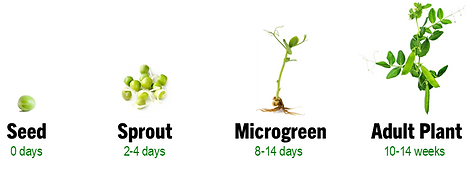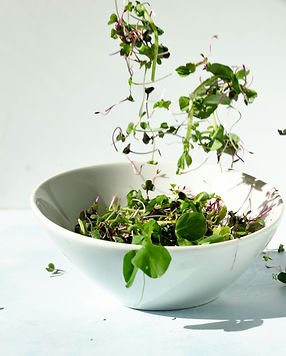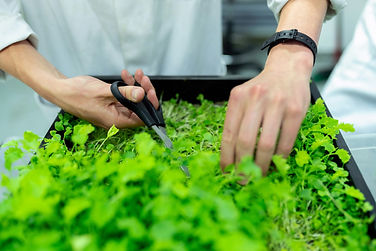Massage Therapy

Microgreens Delivery
What are Microgreens?
The word "micro" says it all. Microgreens are the young seedlings of edible vegetables and herbs. Unlike larger herbs and vegetables that take weeks or months to grow, microgreens are harvested and eaten a week to 10 days after the cotyledon leaves have developed. The cotyledon is the first and tender leaf that emerge when the seed germinates. It is also called the storage unit of the seed, as it provides nutrients to the different parts of a seed embryo. These tiny versions of edible plants only grow to a few inches and can come in 50-60 different varieties. Don't confuse microgreens with sprouts. Sprouts are germinated in water, not soil, for 1-2 days to produced underdeveloped leaves. Microgreens are grown in soil and sunlight and take at least a week to produce leaves, one of the reasons why they are higher in nutritional content.
Microgreens Pack a Nutritional Punch
Don’t be fooled by their small size! Microgreens are highly intense in flavor and nutritional content. In fact, it was discovered in a recent study published by the Journal of agriculture and food chemistry that the concentration of nutrients inside microgreen leaves is highly superior from the concentration you can find in mature plant leaves. In the study, 25 different species of microgreens were analyzed, and it was shown that you can find from 4 up to 40 times more vitamins or carotenoids in the microgreen leaves!
The researchers concluded that most of the microgreen species tested were excellent providers of vitamins and carotenoids, much more even than their mature counterparts. High variations exist between the species, so it’s almost as if each microgreen has its own speciality - in taste but also in nutrients! For example, red cabbage microgreens is extremely high in vitamins C and K, and green daikon has an incredible amount of antioxidants. In any case, just a few grams of microgreens can already be enough to get your daily amount of nutrients.


Healthy
Living foods are among the healthiest foods on the planet. They are packed with concentrated nutrients, vitamins, minerals, and enzymes, containing 4 to 40 times as much nutrients as their adult counterparts. Microgreens, sprouts, and grasses are simply young seeds and legumes that are utilized at their most nutritious and delicious state
Delicious & Easy to Use


SUSTAINABLE
Microgreens are grown more sustainably compared to conventional agricultural practices. They use less water, need no fertilizer or pesticides, and use less land via vertical farming. Our growing trays are reused and our growing medium is composted. Locally grown food results in less pollution from transportation and a more sustainable community.
LOCAL & FRESH
-
Locally grown food is full of flavor. Our microgreens are harvested within 24 hours of delivery vs. being harvested early in order to be shipped and distributed to your local retail store.
-
Has more nutrients. Local food has a shorter time between harvest and your table, and it is less likely that the nutrient value has decreased.
-
Local food supports the local economy. The money that is spent with local farmers and growers all stays close to home and is reinvested with businesses and services in your community.
-
Local food benefits the environment. Purchasing locally grown foods helps maintain farmland and green/open space in your community.
-
Local foods promote a safer food supply. The more steps there are between you and your food’s source the more chances there are for contamination.
-
Local growers can tell you how the food was grown. When you know where your food comes from and who grew it, you know a lot more about that food. Our microgreens are grown from certified organic seeds in organic soil and are free from the use of pesticides and fertilizers.

